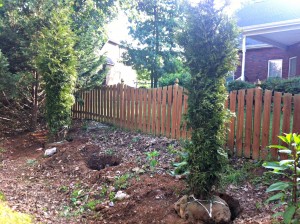You wake up and hear the birds chirping and the sun is shining outside. It’s spring, FINALLY! After a long cold winter, you get the urge to step outside and create something beautiful with the great outdoors. But, how do you succeed the first time? Follow this no-nonsense plan.
I’ve killed more plants than you’ll ever grow. It’s easy to do. Learn from my mistakes. Timing is critical so follow these five steps to 100% success.
I’ve been there before, it’s a challenge to develop the great habits needed to nurse a tender plant into a new permanent place. It’s unnatural in the first place to move plants. They’re made to stay in one place their entire life. It’s almost comical, but plants are successfully transplanted almost everyday of the year.
Season
Spring (March – June) is the best time of the year to plant perennials and annuals. Fall is the best time for trees and shrubs. Realistically, you can transplant (install) plants all year long as long as the temperatures outside don’t bother you.
Don’t let the season slow you down. When you’re ready to succeed, you can plant. I’ve installed successfully February – December.
Right Plant in the Right Place
Whether you’re looking for privacy, color, shade, or food, it’s important that sunlight be considered. Installing most plants in a shady location will minimize success rate. Four hours or more of sunlight is recommended for most plants. If you have shade, follow suit with shade tolerant .
It’s crucial that you know what variety goes where. This is the most important reason to contract with a landscape professional or local garden center. If you’re looking to save time, use an internet search engine. Search sun loving tree, or shade tolerant shrub for ideas. I use Google Images all the time for reference. Double check validity because many images are mislabeled.
Dig A Proper Hole
Don’t get in a hurry! Make the hole twice as wide as the root ball. No deeper than the roots is recommended. It’s ok for the container root ball to be 1-3 inches above the soil line. Loosen soil chunks with your hands or shovel as you fill the empty space in the hole. Don’t try to cram a root system into a tiny hole. You’re setting your new transplant up for failure. As you’re filling the hole with loose soil, add water to create a muddy mixture. This eliminates air space and helps the plant avoid transplant shock.
If you have more than one tree or shrubs to install, pace yourself and dig one hole a day.
Soak with Water, then Allow to Dry
After a successful installation, it’s time to provide daily or weekly irrigation. Most plants benefit from moist, well drained soil. Before irrigating your new transplant, feel the root area with your finger. Is it moist? You may not need to water today. Does the root ball feel dry to the touch? If so, irrigate directly to the roots, avoiding the stems and leaves. For larger plants, it’s perfectly fine to lay the water hose at the trunk and slowly drip water over several hours.
Whatever you do, don’t just spray the canopy and expect the plant to thrive. Soak the roots, then allow them to drain. Moisture is critical to your transplant success.
Inoculate with Mycorrhizae
Soil is alive with billions of microscopic organisms. To help your new transplant establish and become a part of the soil food web, purchase mycorrhizae from a local garden center or the internet. Follow the directions on the package and mix with water. Your transplant success rate will increase because mycorrhizae strengthens root systems. It is absent from most new plants at the garden center. Help your new plants and they will thank you later by needing less water and attention.
What successes and mistakes have you made installing trees and shrubs? Let me know in the comments below.





